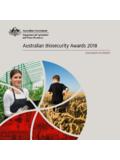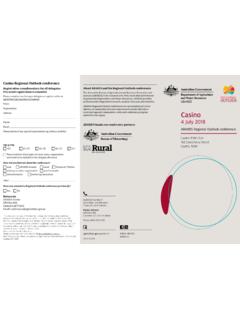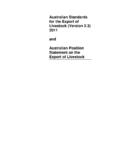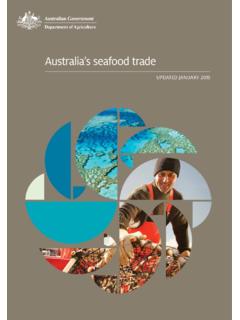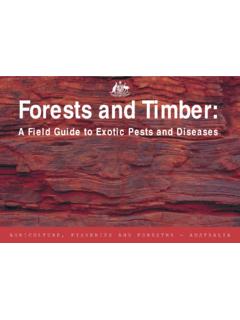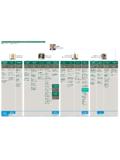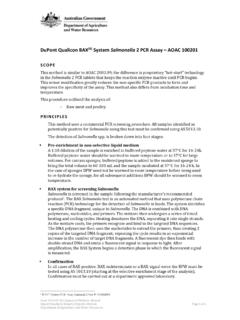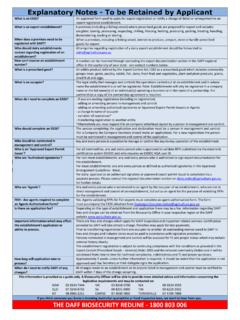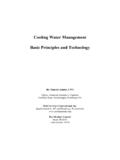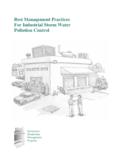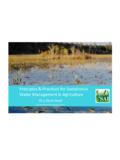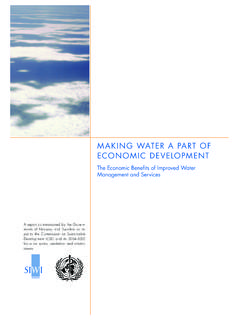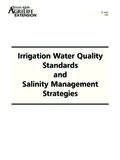Transcription of Australian Ballast Water Management Requirements
1 Australian Ballast Water Management Requirements Version 7 Department of Agriculture and Water Resources Australian Ballast Water Requirements Version 7 1 Commonwealth of Australia 2017 Ownership of intellectual property rights Unless otherwise noted, copyright in this publication (and any other intellectual property rights, if any) is owned by the Commonwealth of Australia. Creative Commons licence All material in this publication is licensed under a Creative Commons Attribution (CC BY) Australia licence, with the exception of content supplied by third parties, logos and the Commonwealth Coat of Arms. The Creative Commons Attribution Australia Licence is a standard form licence agreement that allows you to copy, distribute, transmit and adapt this publication provided you attribute the work. A summary of the licence terms is available from The full licence terms are available from Inquiries about the licence and any use of this document should be sent to Any material sourced from this document should be attributed to the Department of Agriculture and Water Resources, Australian Ballast Water Management Requirements Version 7.
2 Department of Agriculture and Water Resources Postal address GPO Box 858 Canberra ACT 2601 Switchboard +61 2 6272 2000 Facsimile +61 2 6272 2001 Web The Australian Government acting through the Department of Agriculture and Water Resources has exercised due care and skill in preparing and compiling the information and data in this publication. Notwithstanding, the Department of Agriculture and Water Resources, its employees and its advisers disclaim all liability, including liability for negligence, and for any loss, damage, injury, expense or cost incurred by any person as a result of accessing, using or relying upon any of the information or data in this publication to the maximum extent permitted by law. Material in this publication is made available on the understanding that the Commonwealth is not providing professional advice and should not be taken to indicate the Commonwealth s commitment to a particular course of action.
3 Different solutions and outcomes may apply in individual circumstances. Before relying on any material contained in this publication, readers should obtain appropriate professional advice suitable to their particular circumstances. Department of Agriculture and Water Resources Australian Ballast Water Requirements Version 7 2 Contents 1 Introduction .. 3 2 Documents required .. 4 3 Ballast Water reporting .. 6 4 Ballast Water Management options .. 8 5 Acceptable areas for Ballast Water exchange .. 14 6 Ballast Water Management for vessels servicing offshore installations .. 17 7 Exemptions .. 18 8 Disposal of Ballast tank sediment .. 20 9 Practical considerations .. 21 10 Further advice and information .. 24 11 Attachment A: Ballast Water Management Plan and Certificate Requirements .. 25 12 Attachment B: Example Ballast Water Management Certificate .. 27 13 Attachment C: Ballast Water pump test .. 28 14 Attachment D: Maps of Ballast Water exchange exclusion areas.
4 29 15 Glossary .. 32 Version history The Australian Ballast Water Management Requirements are updated periodically. You can check that this version is still current at The following table describes recent changes to the Requirements . Version Date Reason for issue 1 August 2011 Review and update of document to reflect new Ballast Water Management Requirements . 6 6 June 2016 Review and update of document to reflect new Ballast Water Management Requirements under the Biosecurity Act 2015. 7 07 July 2017 Review and update of document to reflect the Biosecurity ( Ballast Water and Other Measures) Amendment Act 2017 and the Biosecurity ( Ballast Water & Sediment) Determination 2017. Department of Agriculture and Water Resources Australian Ballast Water Requirements Version 7 3 1 Introduction The Australian Ballast Water Management Requirements set out the obligations on vessel operators with regards to the Management of Ballast Water and Ballast tank sediment when operating within Australian seas.
5 These Requirements include legislative obligations under the: Biosecurity Act 2015 (Biosecurity Act), and International Convention for the Control and Management of Ships Ballast Water and Sediments ( Ballast Water Convention). They also provides guidance for vessel operators on best practice policies while in Australia. The Requirements apply to all vessels operating internationally and domestically in Australia. The legislative obligations on vessels to manage Ballast Water are contained in the Commonwealth Biosecurity Act 2015 and associated legislation. Vessels following these Requirements will be complying with these obligations. Ballast Water can contain a range of invasive marine species, which, if unmanaged, can lead to significant economic and environmental impacts on Australia s unique maritime environment. This version of the Requirements reflects the implementation of the Ballast Water Convention and other changes associated with the introduction of new national domestic Ballast Water Requirements to reduce the risk of spreading marine pests that have already established in Australian seas.
6 Contact details for more information on these Requirements is included in Section 10. Checklist for Masters This checklist is to assist masters in complying with these Requirements and includes page references for more information. Ensure the vessel has a Ballast Water Management Plan (BWMP, Management plan) and Ballast Water Management Certificate (BWMC, Management certificate) as set out in Section 2. Ensure all operations are recorded in the Ballast Water Record System, as described in Section 2. Ensure the vessel has met the reporting obligations set out in Section 3. Ensure all Ballast Water is managed in accordance with Section 4. Department of Agriculture and Water Resources Australian Ballast Water Requirements Version 7 4 2 Documents required Key points All vessels must carry a valid Management plan Most vessels will also require a Management certificate Vessels with a Ballast Water Management system (BWMS) should also carry a Type Approval Certificate specific to the type of BWMS All vessels must maintain a complete and accurate record of all Ballast Water movements For clarification of Requirements for different vessel types please refer to Attachment A Ballast Water Management Plans All vessels designed to carry Ballast Water are required to carry a valid Management plan.
7 A valid BWMP must be approved by either a survey authority, classification society, or the Administration of the vessel. For Australian flagged vessels, a Management plan must be approved by the Director of Biosecurity, or an approved survey authority. BWMPs should be consistent with the Ballast Water Convention s Guidelines for Ballast Water Management and Development of Ballast Water Management Plans (G4 Guidelines). The BWMP must: be vessel specific (vessel name and International Maritime Organization (IMO) number) be approved by a survey authority, recognised organisation, or the vessel s flag administration nominate the rank(s) of the responsible officer and crew contain the Ballast Water Management method and pumping rates. Non commercial vessels that are less than 400 gross tonnes are exempt from carrying Management plans. Vessels with sealed tanks may also be eligible for an exemption upon application. Refer to Section 7 for details on seeking an exemption.
8 Ballast Water Management Certificates A Management certificate is required for all vessels to which the Ballast Water Convention applies. The majority of Australian domestic vessels designed to carry Ballast Water will also need to obtain a Ballast Water Management certificate. Attachment A lists the certification Requirements for different classes of vessel. A BWMC verifies the vessel has been surveyed to a standard compliant with the Ballast Water Convention, and must be consistent with the format described in Appendix I of the Ballast Water Convention. A statement of fact, or a certificate of compliance, is also accepted for vessels flagged to an administration that is not party to the Ballast Water Convention. A valid BWMC must be issued by either a survey authority, classification society, or the administration of the vessel, and be in accordance with Regulation E 1 of the Ballast Water Convention. For Australian flagged vessels, a Management certificate must be issued by the Director of Biosecurity, or an approved survey authority.
9 Department of Agriculture and Water Resources Australian Ballast Water Requirements Version 7 5 The certificate should: be vessel specific (vessel name and IMO number) be ratified by a survey authority or recognised organisation state the principal Ballast Water method(s) used (Regulation D1 (Exchange Standard) or Regulation D2 (Treatment Discharge Standard) or Regulation D4 (Prototype System)) certify Regulation E 1 in fine print (survey schedule) have an end date up to five years from time of inspection. A reference to Regulation D 1 on a BWMC will suggest the vessel utilises Ballast Water exchange. Whereas, a reference to Regulation D 2 suggests the vessel utilises a BWMS. If Regulation D 2 has been selected, the Management certificate should clearly state the name of the system. Floating platforms, Floating Storage Units (FSUs) and Floating Production, Storage and Offloading Units (FPSOs) are required to obtain a BWMP and BWMC.
10 The survey schedule required for these vessels is not required to follow the schedule specified in Regulation Certification for floating platforms, FSUs and FPSOs may remain valid for a maximum of five years in between surveys. An example of valid certificates is provided in Attachment B. Type Approval Certificate For vessels with a BWMS, also known as a Ballast Water treatment system, a Type Approval Certificate should be retained on board. A Type Approval Certificate relates specifically to the Ballast Water Management system, and is not vessel specific. Ballast Water Record System All vessels that carry Ballast Water must maintain a complete and accurate Ballast Water Record System (Record System). The system may be electronic or in hard copy, and should comply with Regulation B 2 of the Annex to the Ballast Water Convention. The Record System should contain a complete record of all Ballast Water movements. Records that should be kept in the vessel s Ballast Water recording system when conducting a Ballast Water exchange are: start and finish coordinates start and finish times for pumping Water during an exchange actual pumping times (these should not be affected by the crossing of time zones) residual volume remaining in the tank at the end the empty cycle prior to refill (empty refill method only) signature of the officer in charge of the operation.
